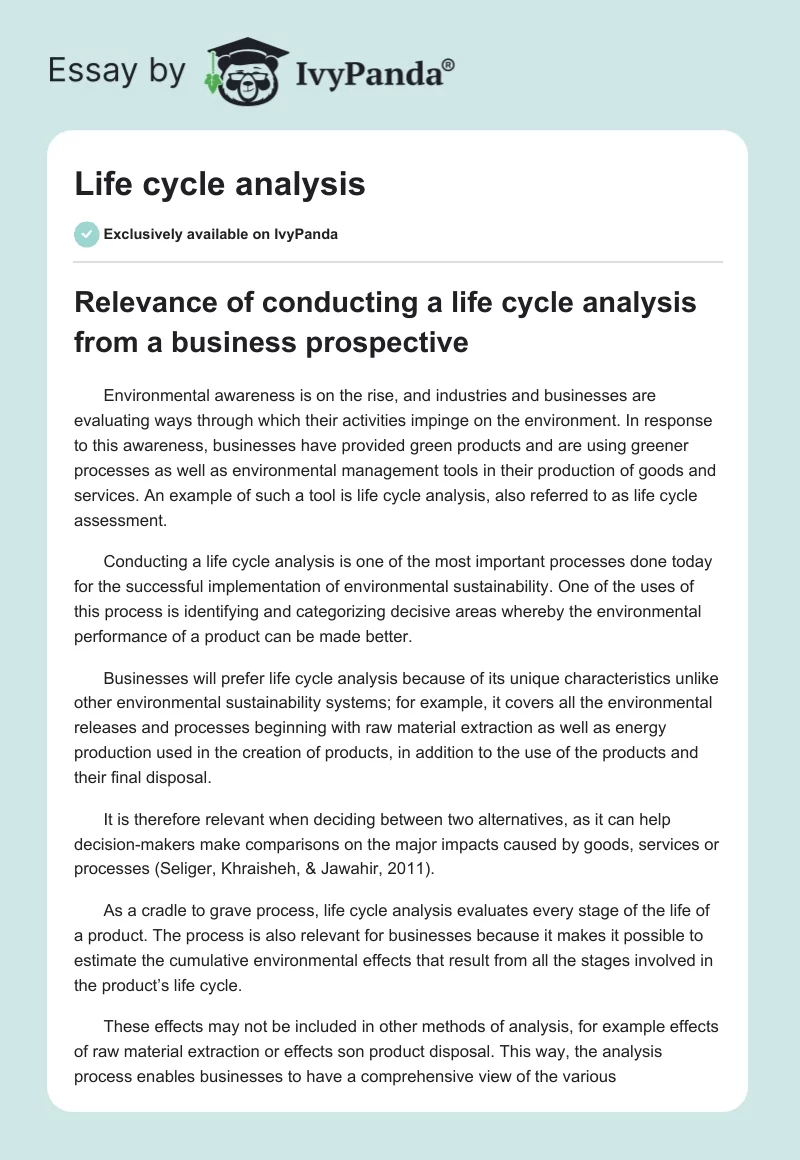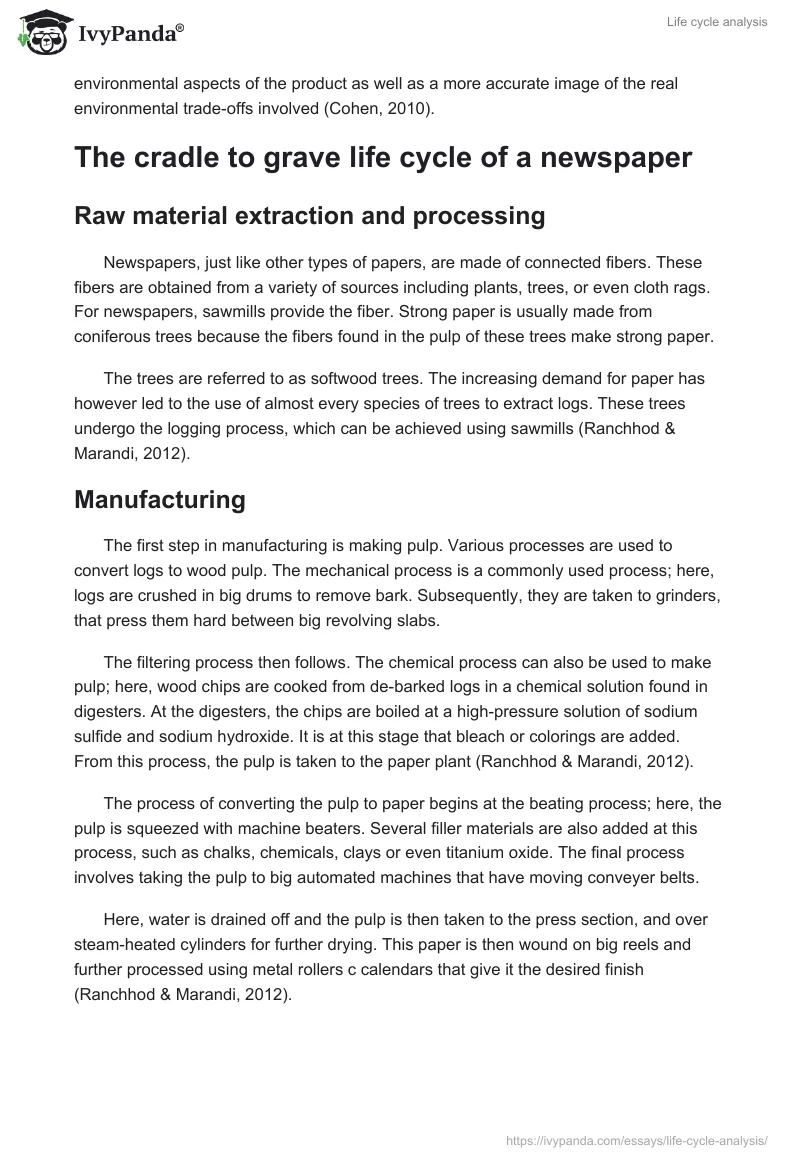Relevance of conducting a life cycle analysis from a business prospective
Environmental awareness is on the rise, and industries and businesses are evaluating ways through which their activities impinge on the environment. In response to this awareness, businesses have provided green products and are using greener processes as well as environmental management tools in their production of goods and services. An example of such a tool is life cycle analysis, also referred to as life cycle assessment.
Conducting a life cycle analysis is one of the most important processes done today for the successful implementation of environmental sustainability. One of the uses of this process is identifying and categorizing decisive areas whereby the environmental performance of a product can be made better.
Businesses will prefer life cycle analysis because of its unique characteristics unlike other environmental sustainability systems; for example, it covers all the environmental releases and processes beginning with raw material extraction as well as energy production used in the creation of products, in addition to the use of the products and their final disposal.
It is therefore relevant when deciding between two alternatives, as it can help decision-makers make comparisons on the major impacts caused by goods, services or processes (Seliger, Khraisheh, & Jawahir, 2011).
As a cradle to grave process, life cycle analysis evaluates every stage of the life of a product. The process is also relevant for businesses because it makes it possible to estimate the cumulative environmental effects that result from all the stages involved in the product’s life cycle.
These effects may not be included in other methods of analysis, for example effects of raw material extraction or effects son product disposal. This way, the analysis process enables businesses to have a comprehensive view of the various environmental aspects of the product as well as a more accurate image of the real environmental trade-offs involved (Cohen, 2010).
The cradle to grave life cycle of a newspaper
Raw material extraction and processing
Newspapers, just like other types of papers, are made of connected fibers. These fibers are obtained from a variety of sources including plants, trees, or even cloth rags. For newspapers, sawmills provide the fiber. Strong paper is usually made from coniferous trees because the fibers found in the pulp of these trees make strong paper.
The trees are referred to as softwood trees. The increasing demand for paper has however led to the use of almost every species of trees to extract logs. These trees undergo the logging process, which can be achieved using sawmills (Ranchhod & Marandi, 2012).
Manufacturing
The first step in manufacturing is making pulp. Various processes are used to convert logs to wood pulp. The mechanical process is a commonly used process; here, logs are crushed in big drums to remove bark. Subsequently, they are taken to grinders, that press them hard between big revolving slabs.
The filtering process then follows. The chemical process can also be used to make pulp; here, wood chips are cooked from de-barked logs in a chemical solution found in digesters. At the digesters, the chips are boiled at a high-pressure solution of sodium sulfide and sodium hydroxide. It is at this stage that bleach or colorings are added. From this process, the pulp is taken to the paper plant (Ranchhod & Marandi, 2012).
The process of converting the pulp to paper begins at the beating process; here, the pulp is squeezed with machine beaters. Several filler materials are also added at this process, such as chalks, chemicals, clays or even titanium oxide. The final process involves taking the pulp to big automated machines that have moving conveyer belts.
Here, water is drained off and the pulp is then taken to the press section, and over steam-heated cylinders for further drying. This paper is then wound on big reels and further processed using metal rollers c calendars that give it the desired finish (Ranchhod & Marandi, 2012).
Purchase, use, and disposal
The newspaper printing process is responsible for the purchase and use of papers from the paper mill, for use by the printing press of newspapers. During newspaper printing, a lot of energy and raw materials are consumed, for example inks and printing plates. The printing press purchases paper from the paper mill.
The disposal of newspaper is done through several ways. One is recycling, whereby the newspapers are taken back to the paper mill and, using chemical processes, are transformed anew. Land filling can also be used to dispose of the newspapers (Hesselbach & Herrmann, 2011).
Waste management
Waste management in the life cycle analysis of newspapers is done in various phases of the cycle. A thorough analysis of this process reveals that it is during the paper mill stage that the most emissions are produced. It is also in this stage that the most resources are consumed, largely because of its high-energy consumption. The landfilling process is also responsible for high emissions, considering the high methane emissions of the disposal process compared to other stages of the life cycle.
Various waste management solutions are developed, and the following conclusions and recommendations can be established. The inclusion of the production stages of the waste management process, this can help in obtaining a realistic picture of the relevance of the individual life cycle phases on the general impacts (Dahlbo et al, 2005).
Paper is one of the biggest contributors of solid waste components. It is also a material that originates from a very important natural resource whose maintenance and sustainability is crucial, the forest. It is recommended that during the manufacture process, newspapers can be co-combusted or incinerated. These modern waste management processes have the capability to decrease using de-inked pulp.
Otherwise, using virgin fiber-based pulp in the manufacture of newsprint is more effective. During the treatment and waster recovery stage, it is important to remember that landfilling of newspapers in their untreated state is environmentally worse compared to their energy recover (Hesselbach & Herrmann, 2011). In its disposal management, the combustion of newspaper using solid recovered fuel, rather than coal can save significant amount of energy.
References
Cohen, N. (2010). Green Business: an A-Z Guide. New York: SAGE.
Dahlbo, H., Koskela, S., Laukka, J., Myllymaa, T., Jouttijärvi, T., Melanen, M. & Tenhunen, J. (2005) Life cycle inventory analyses for five waste management options for discarded newspaper. Waste Management and Research 23:1-13.
Hesselbach, J., & Herrmann, C. (2011). Glocalized Solutions for Sustainability in Manufacturing:Proceedings of the 18th CIRP International Conference on Life Cycle Engineering, Technische Universität Braunschweig, Braunschweig, Germany, May 2nd- 4th, 2011. London: Springer.
Ranchhod, A., & Marandi, E. (2012). CIM Coursebook 07/08 Strategic Marketing in Practice. London: Routledge.
Seliger, G., Khraisheh, M. M., & Jawahir, I. (2011). Advances in Sustainable Manufacturing. New York: Springer.


